What follows is a joint investigation of Smut Clyde and Tiger BB8 who tracked a string of fraudulent nanotechnology data and uncovered a maze of seemingly unrelated yet secretly connected Chinese authors, a treasure trove of reusable figures, diabetic rats rising from the dead to be treated with nanoparticles or with a “herbal” soup, depending on the language of publication. Most English papers even have give-away titles: “Fabrication of…”, an attempt at humour maybe.
The main characters here are a certain fabricator named Junyi Shen, who did a doctorate at Shanghai University of Traditional Chinese Medicine, and his new boss Hui Cai, professor of Traditional Chinese Medicine with a desire to cure all diseases with fabricated nanoparticles. Because the civilian Dr Cai works in a military hospital in Nanjing, he sports an army rank which is equivalent to Colonel, and a bunch of medals, epaulettes and other military insignia to prove it.
In brief: Shen apparently set up a peer review ring between Nanjing and Shanghai, where he and other academic crooks use same images of brains or cells, flow cytometry plots or nanoparticle distribution histograms all over again (only Shen knows where all those originally got fabricated), with the end result that same figure appeared in papers which share no common authors. The context it was used in varies: different diseases, different treatments, and occasionally the pictures get rudely photoshopped, for example to make a healthy brain look like an infarcted one. Sometimes the rats were allegedly treated with ginseng-flavoured nanoparticles, sometimes they were described as force-fed with a “herbal” soup which was not entirely herbal after all. But because the papers are either English or Chinese, who would have noticed, right? Smut Clyde and Tiger BB8 did.
The Ring of Fabricationists, by Smut Clyde and Tiger BB8
Is it time for another dive into PubPeer threads, to exploit the unpaid labour of anonymous contributors there? Apparently it is. Along the way I learned that if you put googly eyes onto a slice of partly-necrotic rat brain, it turns into a guineapig.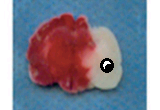
This post will be shorter than usual as I only touch on seven papers. All fall under the rubric of ‘drug delivery”… the goal of encapsulating or binding some drug so that it arrives or concentrates at some targetted spot in the body, where it is released from its bonds at a desired pace. In practice ‘encapsulation’ means ‘nanotechnology’. Thus four of the papers came out in International Journal of Nanomedicine (IJN) from Dove Press (a pay-to-print open-access publisher that once earned Jeffrey Beall’s disapproval for having negotiable reviewing standards, later acquiring higher ideals when it was bought by Taylor & Francis). Two other papers appeared in Artificial Cells Nanomedicine and Biotechnology (ACN&B, the Taylor & Francis group’s own home-grown addition to their open-access stable).
Entering into detail: three of the seven papers involve a rat model of cerebral ischaemia (treatment of strokes, to discourage the insulted brain cells from self-destructing after blood-flow is resumed). They hail from Hui Cai’s laboratory at the
Department of Integrated Traditional and Western Medicine, Jinling Hospital, School of Medicine, Nanjing University, Nanjing.

In this helpful summary diagram, they’re enclosed by the central angular box. The following papers shall be called
The English Collection
- 1. “Ginsenoside Rg1 nanoparticle penetrating the blood–brain barrier to improve the cerebral function of diabetic rats complicated with cerebral infarction” Shen et al. IJN (2017).
- 2. “Fabrication of a nano polymer wrapping Meg3 ShRNA plasmid for the treatment of cerebral infarction” Shen et al. ACN&B (2018).
- 3. “Fabrication and evaluation a transferrin receptor targeting nano-drug carrier for cerebral infarction treatment” Shen et al. ACN&B (2019).
The other four were brought to us by a looser network of researchers in Shanghai. Two aim to improve the targetted toxicity of chemotherapy drugs;
- 4. “Fabrication of poly(γ-glutamic acid)-based biopolymer as the targeted drug delivery system with enhanced cytotoxicity to APN/CD13 over-expressed cells” Zhang et al. Journal of Drug Targeting (2015).
- 5. “Fabrication and evaluation of a γ-PGA-based self-assembly transferrin receptor-targeting anticancer drug carrier” Zhang et al. IJN (2018).
and two involve treating arthritis with triptolide, nanopackaging the drug in different polymers to reduce its toxicity.
- 6. “Fabrication of novel vesicles of triptolide for antirheumatoid activity with reduced toxicity in vitro and in vivo” Liang et al. IJN (2016).
- 7. “Fabrication of a triptolide-loaded and poly-γ-glutamic acid-based amphiphilic nanoparticle for the treatment of rheumatoid arthritis” Zhang et al. IJN (2018).
But these are not the only actors in the dramatis personae. Prepare yourself for FACS histograms, distributions of nanoparticle size, drug-release curves, and a cast of images that were supposed to illustrate distinct conditions but overlap.
From (2):
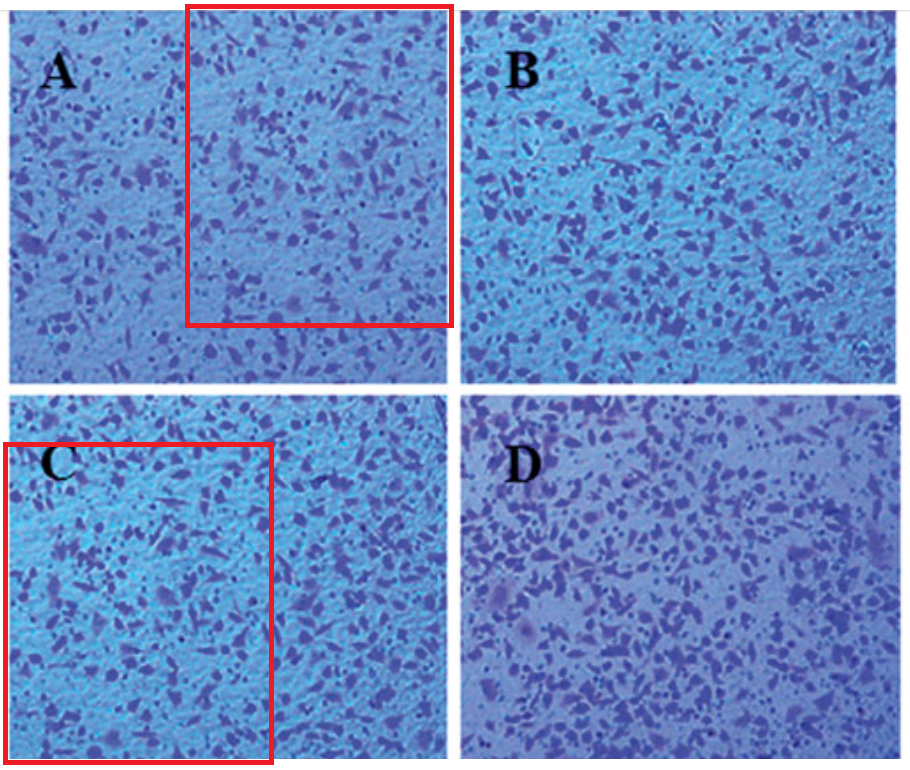
(5):
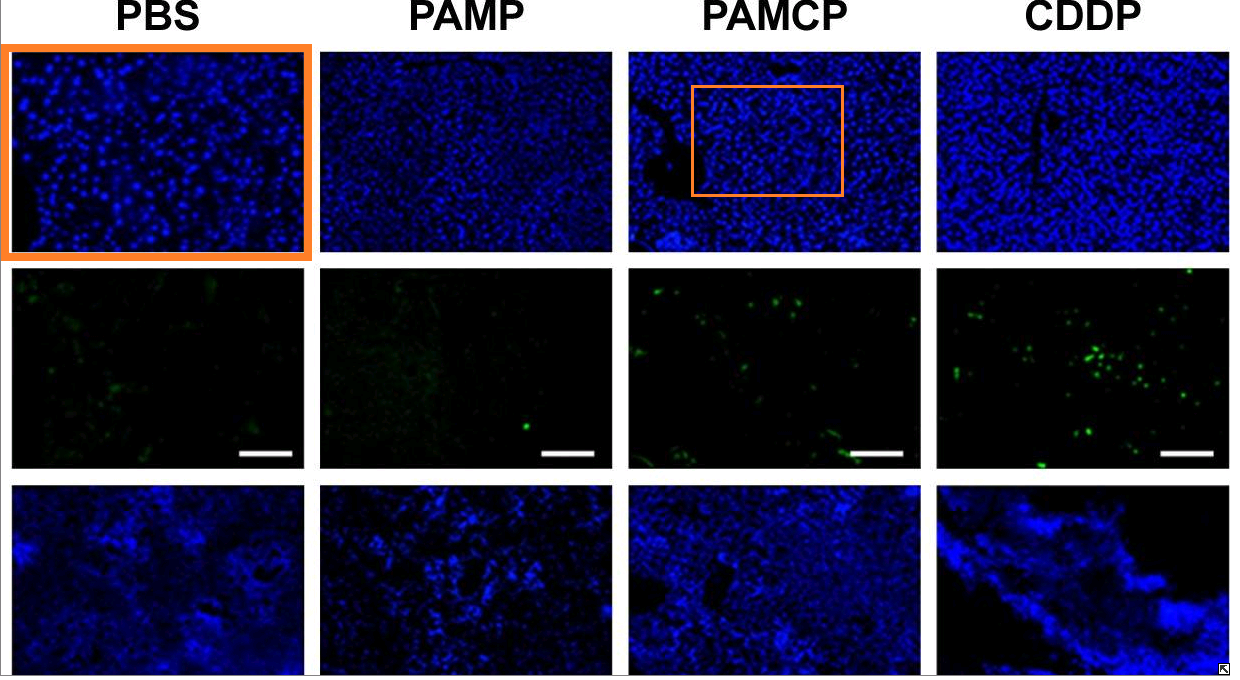
(6) and (7):
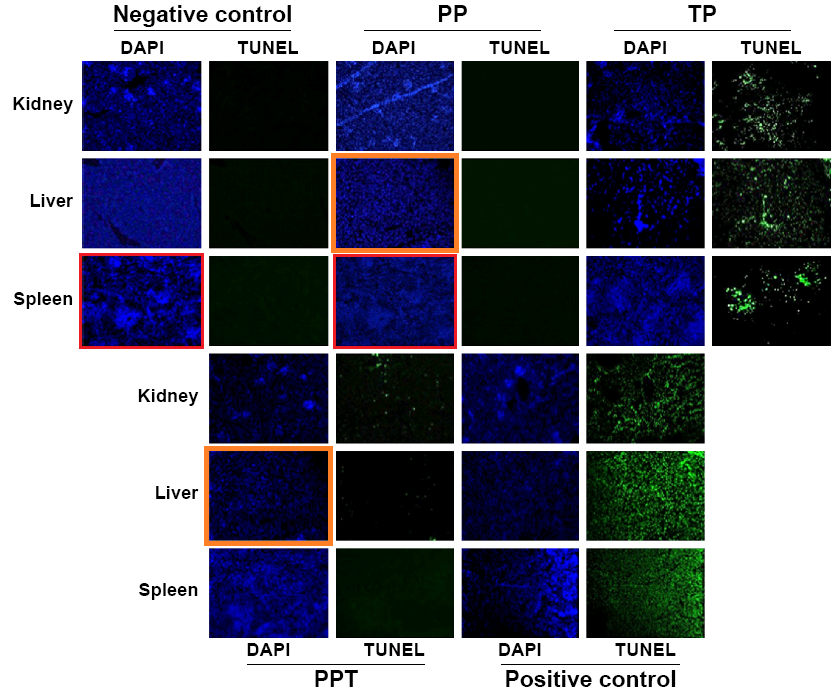
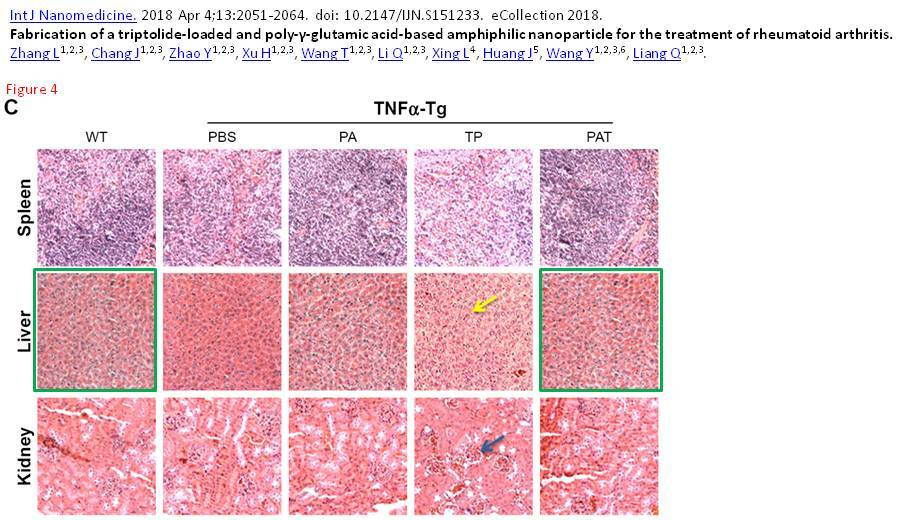
One cannot read much into these, although the post-publication reviewers at PubPeer can be commended for their eagle vision, while the authors and publishers can be urged to correct the errors.
Oh yes, and some appetising slices of rodent brains. To provide the cerebral ischaemia in (2), a fine thread was pushed up the carotid artery of each rat, far enough to occlude the middle cerebral artery on that side and interrupt the blood-flow. Thus Figure 6, where the white zones have been stained to depict the damaged areas: largest in column (B), where the rats received no treatment after blood-flow resumed. Brains in column (A) received no maltreatment other than the slicing.
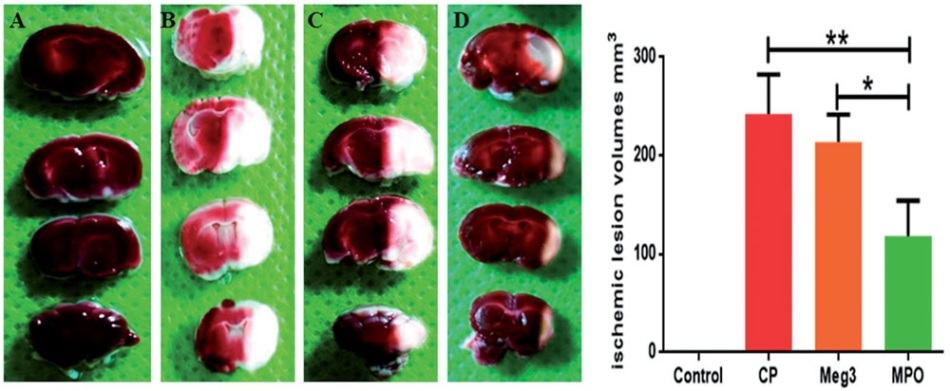
A similar process in (3) – though using a peptide / ginsenoside / ‘nanocarrier’ combination instead of nanoencapsulated RNA plasmids – produced that paper’s Figure 5.
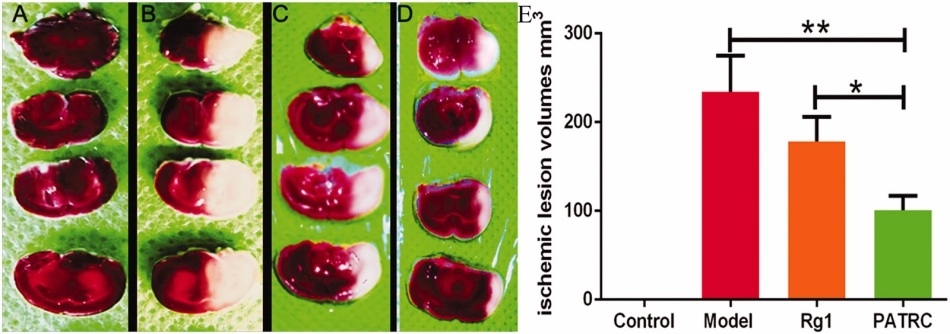
The punchline here is that the brains shown in Column (3)(B) are the same as in (2)(A), only flipped vertically, with the contrast turned up to “garish” and half of each slice bleached out in Photoshop. The texture of the matting is the same; the shadows and the reflected highlights are identical. (3)(A) shows the same slices as well, though with a change in the lighting. It is tempting to apply skeptical statistical scrutiny to the analyses of the measurements, but this becomes less urgent if the phenomena being measured never existed outside of Photoshop.
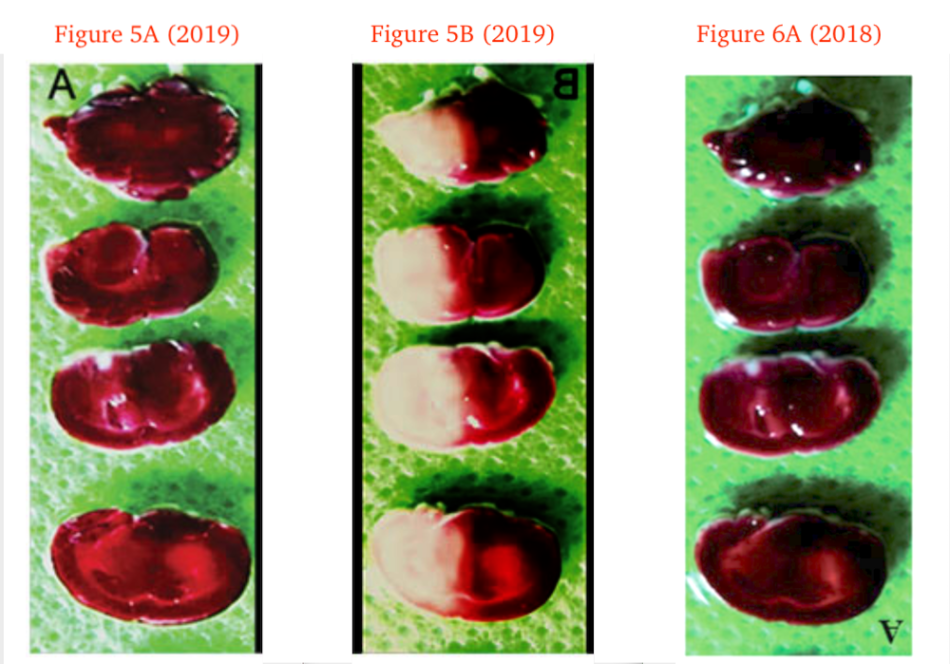
Recall the team’s affiliation: “Department of Integrated Traditional and Western Medicine”. It illustrates the awkward quandary that Chinese researchers face. Last year an official edict against data-faking shenanigans came down, and was widely reported, with its warnings of condign punishment. This new policy coexists with the official state support for TCM (‘traditional Chinese medicine’), under which researchers are expected to find the ingredients of TCM to be at least as effective as drugs from other sources, i.e. data-faking is compulsory. Some wondered at the time whether the policy would be enforced with majestic impartiality, or just against poorly-connected out-of-favour individuals. Is it too early to ask how the crackdown on fraud is going?
The expectation operates at the institutional level, and the upper echelons and PIs in any Institute of “Integrated Traditional and Western Medicine” must necessarily be appointed for ideological rigour, perhaps to the exclusion of competence and incorruptible integrity. So in (1) and (3), Hui Cai’s team addressed a component of ginseng squeezings (‘ginsenoside Rg1’), which seemed to discharge their responsibilities enough to let them experiment with RNA plasmids in (2).
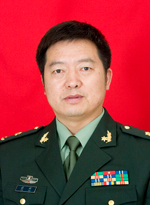
Anyway, here is Hui Cai, in uniform with a multicoloured barcode on his chest. Jinling Hospital is a military asset, operated by the People’s Liberation Army (the commercial, corporate role of the PLA, as a special sector of the Chinese economy, far outweighs its ostensible purpose of winning battles).
Moving along, Leonid’s readers will be familiar with FACS flow-cytometry plots: measuring the level of protein (or in the following case, phospholipid) markers on the membranes of cells and plotting them as coordinates to locate each cell as a point in a 2D distribution. I am no expert on this technique but it does not seem normal for the distributions to have sharp-edged voids punched out of them, as if sliced with a cookie-cutter (3).
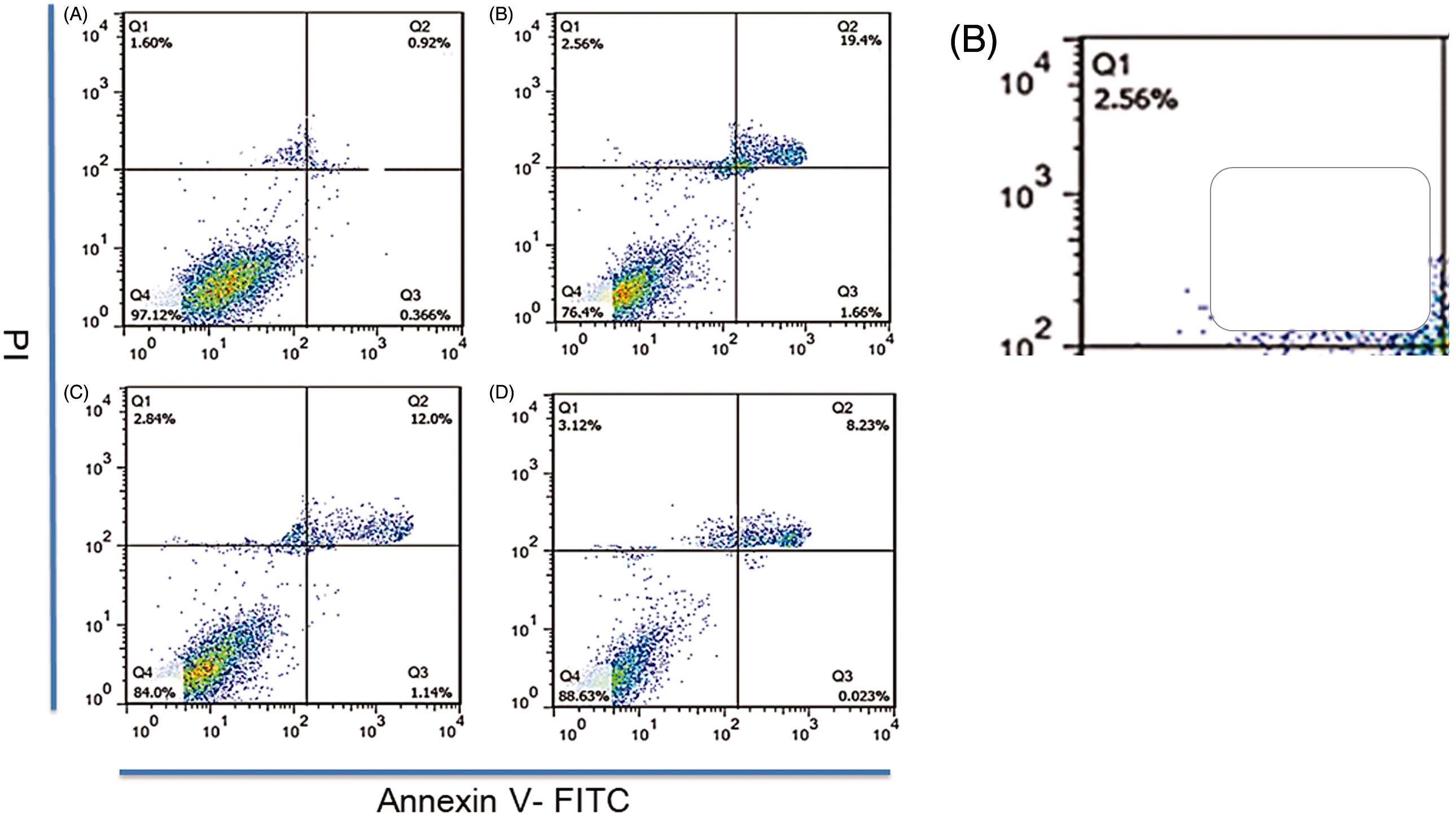
Of course FACS data can be plotted as 1D distributions, histograms plotting the number of cells counted at each level of a single membrane marker fluorescence. Here, from (2),
“Figure 2. In vitro MPO RBE4 cell targeting assay. The cell targeting detected by flow cytometry assay (A–D) …. In vitro flow cytometry analysis of the MPO targeting. (A) RBE4 cells incubated with PBS, (B) RBE4 incubated with control plasmid, (C) RBE4 incubated with Meg3 plasmid, (D) RBE4 incubated with MPO”.

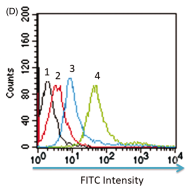 And from (3),
And from (3),
“Figure 2. … RBE4 targeting of PATRC was detected by flow cytometry method. (D,1) RBE4 cells incubated with PBS; (D,2) RBE4 incubated with iTP (10 μg/ml); (D,3) RBE4 incubated with PATRC (containing 10 μg/ml TP); (D,4) RBE4 incubated with TP (10 μg/ml).”
It is not good when “RBE4 cells incubated with PBS” and “RBE4 incubated with iTP” follow identical distributions.
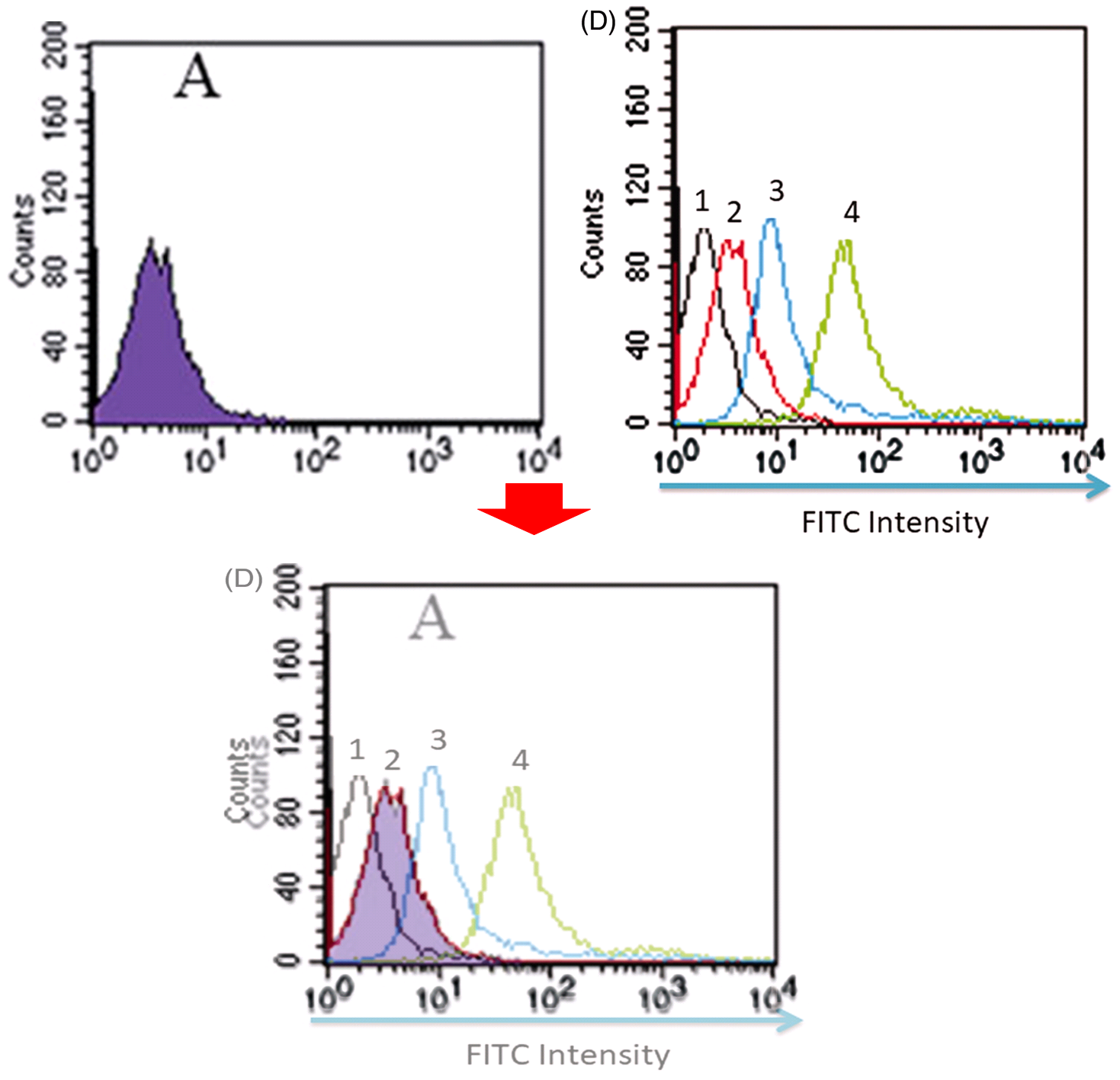
Nor is it reassuring to find that “RBE4 incubated with control plasmid” and “RBE4 incubated with Meg3 plasmid” follow the same distributions as “(A) HUVEC cells incubated with PBS showed fluorescence intensity of 3.75, (B) HUVEC cells incubated with P40 (50 mg/ml) with fluorescence intensity of 10.4”.
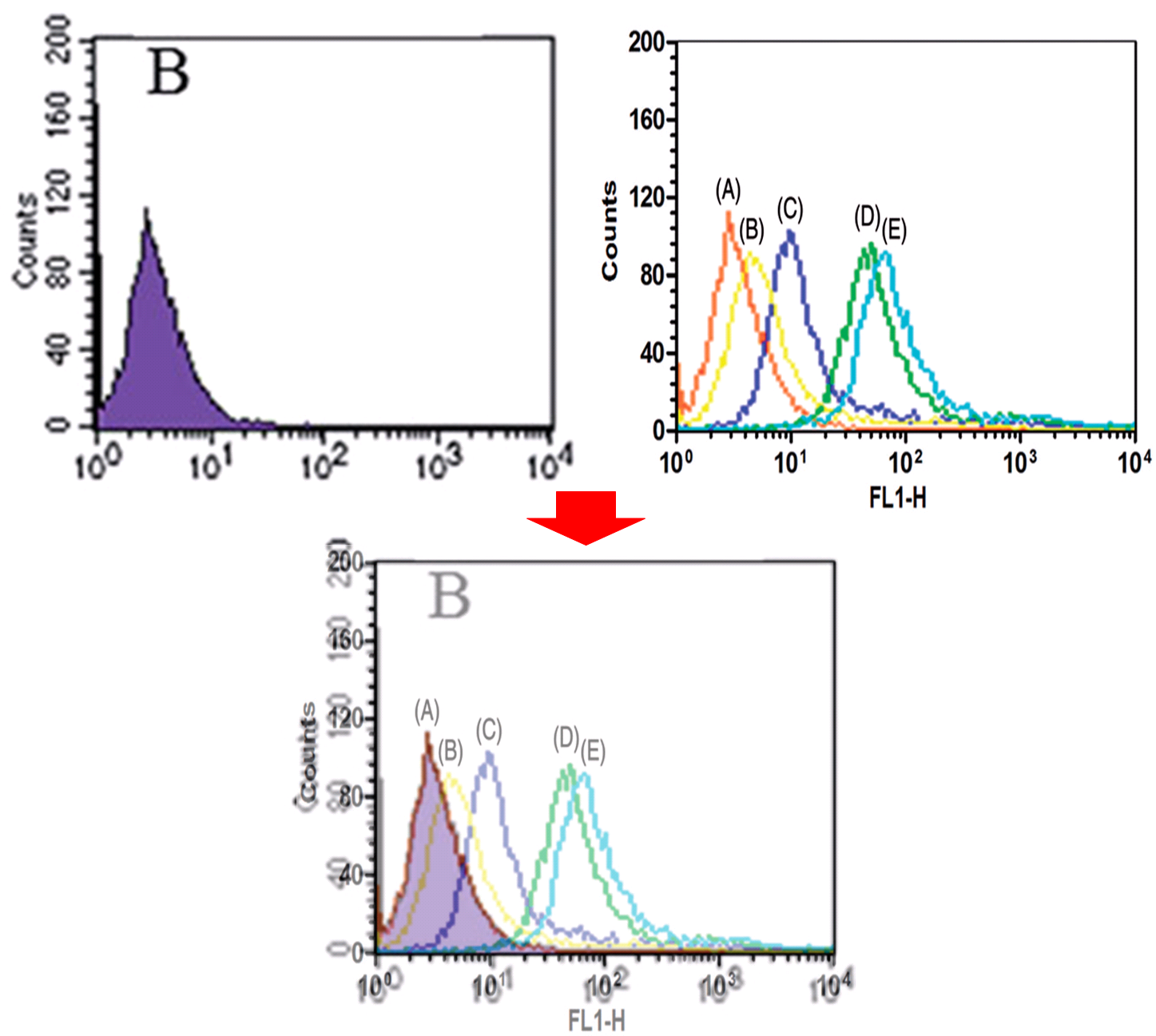
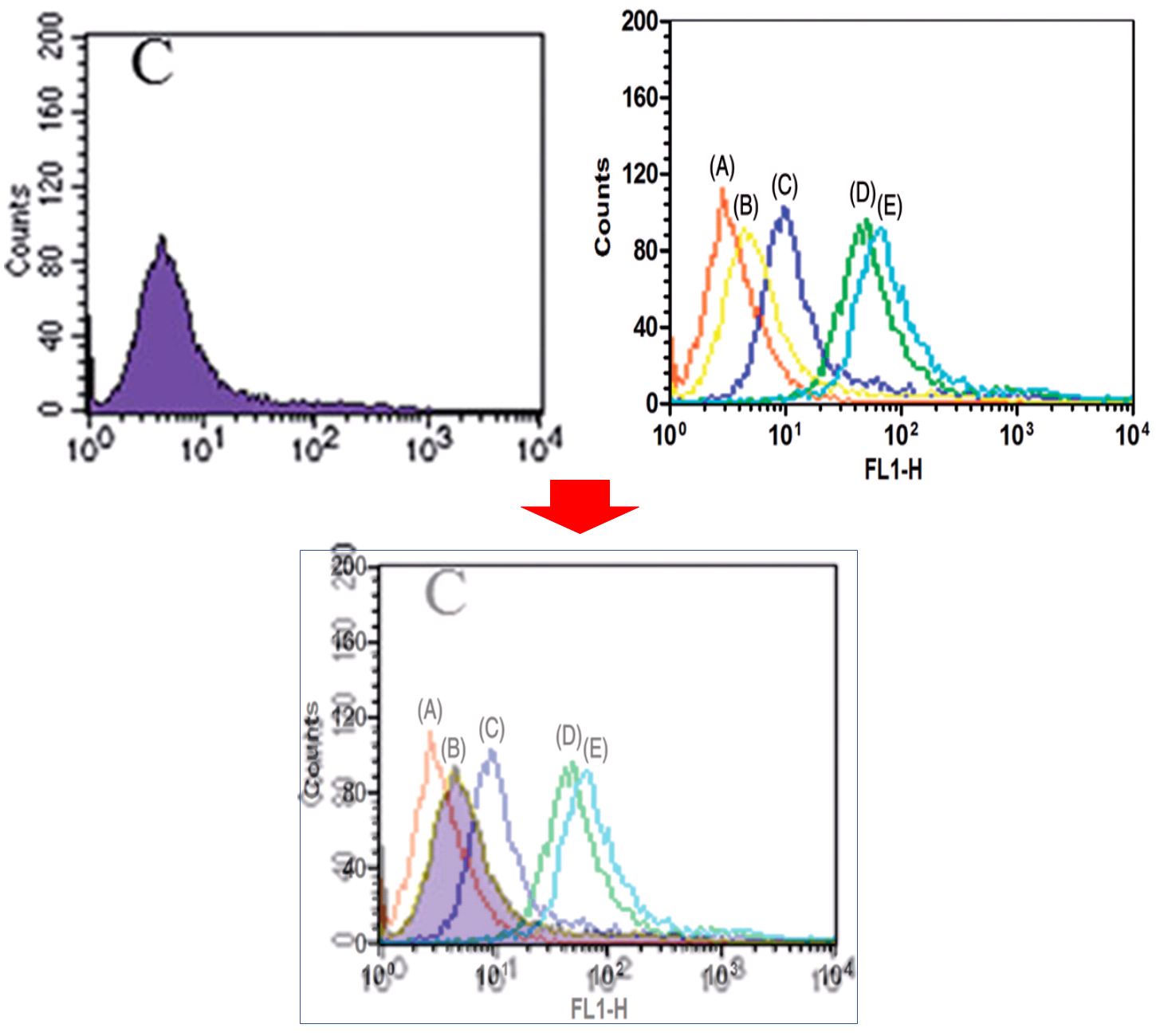
Here I have broadened the scope to include papers from the Shanghai network, and (4) in particular, for those authors provided a third set of charts for a third set of FACS conditions (Figure 5).
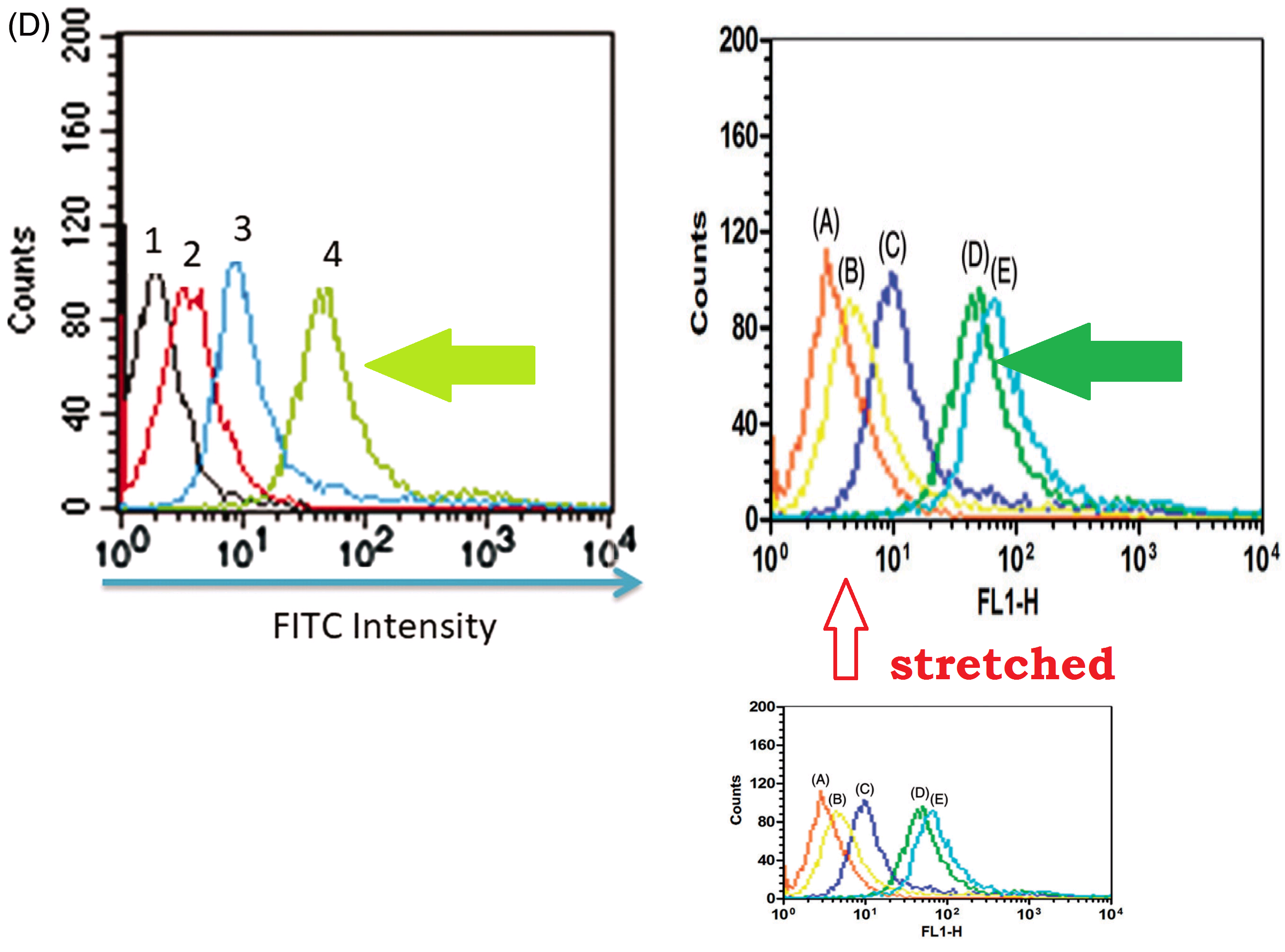 So “RBE4 incubated with TP (10 μg/ml)” and “HUVEC cells incubated with PAMCN (equal to 50 mg/ml mNGR) with fluorescence intensity of 99.77” again behave with surprising similarity. There is a single pool of FACS histograms, and two groups of researchers are dipping into it any time they need to illustrate a purported experiment. Who acquired that pool, and how it came to be shared between laboratories, these remain a mystery.
So “RBE4 incubated with TP (10 μg/ml)” and “HUVEC cells incubated with PAMCN (equal to 50 mg/ml mNGR) with fluorescence intensity of 99.77” again behave with surprising similarity. There is a single pool of FACS histograms, and two groups of researchers are dipping into it any time they need to illustrate a purported experiment. Who acquired that pool, and how it came to be shared between laboratories, these remain a mystery.
Coincidences continue when we follow our curiosity to the ‘Arthritis’ pair of papers. Here are two charts from (1) and (6). The only difference seems to be whether it is triptolide or ginsenoside Rg1 being progressively released from different carriers and fitted with exponential curves.
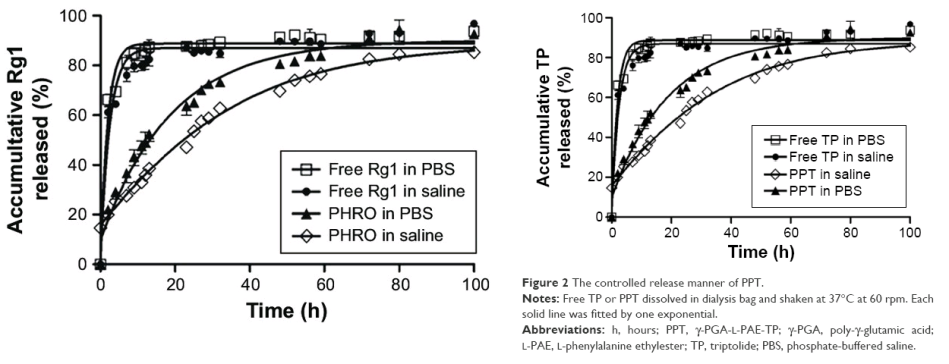
Mirabile dictu, many of the same data points appeared for a third time in (7), albeit with an additional measurement at time = 120 hours, and a concomitant shift on the vertical axis. Given the high confidence of the values (indicated by the error bars on some points), the convergence is a remarkable finding, worthy of a publication in its own right.

The authors of (6) and (7) responded, explaining the convergence on the familiarity of the materials – poly-γ-glutamic acid-grafted di-tert-butyl L-aspartate hydrochloride [PAT] versus poly-γ-glutamic acid-grafted l-phenylalanine ethylester copolymer [PPT]. They did not venture an opinion on the Nanjing team’s possession of the same chart.
One mystery remains. As noted by ‘Indigofera Tanganyikensis‘, initiating this thread of inquiry, a single size distribution characterises the nanoparticles in five of these seven papers. In the helpful diagram above, they’re enclosed by the dotted curved line.
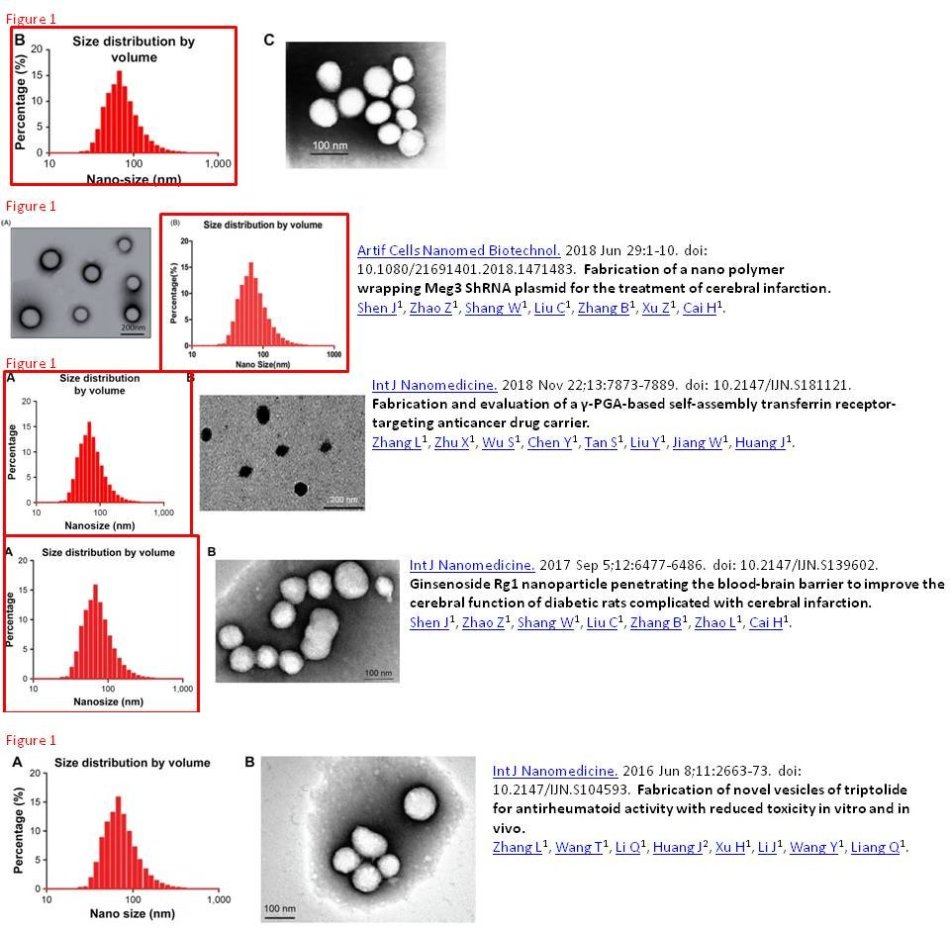
Shanghai to Nanjing and back
As mysterious as it is, why would seemingly unconnected groups of authors share same figures and plots across their separate papers? To solve the mystery, let’s track the authors’ background and their publications in Chinese journals.
The first clue came from the funding source of the three Junyi Shen papers from the Nanjing group. A single grant from the National Natural Science Foundation of China (NSFC) that was tied to no-one in the author list of these Shen papers, not even to the Nanjing Jinling Hospital where the authors work. How can this be? Why would the signatory principle investigator (PI) of this grant, Dr. Bangjiang Fang from Shanghai University of TCM, sponsor the research in Nanjing Jinling hospital, without being included as a co-author himself, without having at least his university listed as the place where the research was conducted?
A search on Chinese scientific publication database Zhi Wang (Zhi Wang means The Web of Knowledge) and Wan Fang academic database revealed a connection between Shen, the first author of the Nanjing papers, and Fang, the PI of the NSFC grant.
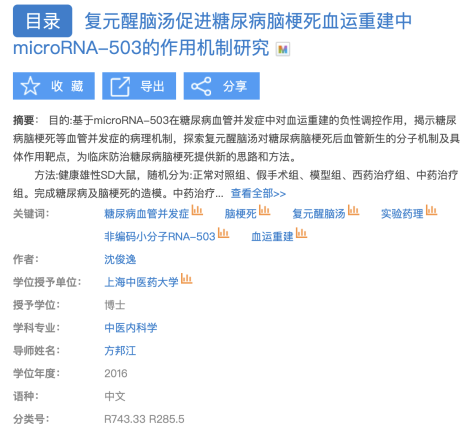
Records at Wan Fang (above) show that Shen earned his PhD on “TCM version” of internal medicine from Shanghai University of TCM in December 2016 under Dr. Fang and yet another source showed that Shen subsequently received a postdoctoral fellowship from Nanjing Jinling Hospital to train under his new postdoc mentor, Dr. Hui Cai, the senior and corresponding author of the Nanjing papers.
During his career from 2012 to 2019, Shen authored or co-authored 17 journal papers in Chinese listed below (herein we shall call them The Chinese Collection). Among them, papers 3 and 4 were written together with both his Shanghai professors and Nanjing colleagues, 1, 2, and 5-7 were with his Nanjing community only, and papers 8-17 feature only Shanghai professors and lab mates. These papers provided the figure data later published in the English-language papers. The experimental procedures changed in between, yet the pictures stayed the same.
The Chinese Collection
1 人参皂苷Rg1纳米颗粒的构建、表征和体外功能研究. 沈俊逸;赵智明;刘春丽;壮雨雯;徐文俊 东南国防医药 2019-01-20
2 复元醒脑汤对糖尿病脑梗死大鼠BMECs的影响及miRNA-320的调控机制研究. 沈俊逸;赵智明;刘春丽;壮雨雯;徐文俊 天津中医药 2019-01-12
3 复元醒脑汤对糖尿病脑梗死大鼠microRNA-503及CCNE1、CDC25A蛋白表达的影响及对促进血管新生的实验研究 沈俊逸;方邦江;赵智明;刘春丽;壮雨雯;徐文俊;蔡辉 中国中医急症 2018-11-15
4 复元醒脑汤对糖尿病脑梗死大鼠BMECs的影响及microRNA-503的调控机制研究 沈俊逸;方邦江;赵智明;刘春丽;壮雨雯;徐文俊;蔡辉 浙江中医杂志 2018-10-16
5 复元醒脑汤对糖尿病脑梗死大鼠神经缺损行为及糖脂代谢的干预作用 沈俊逸;赵智明;刘春丽;壮雨雯;徐文俊;蔡辉 西部中医药 2018-07-15
6 复元醒脑汤对糖尿病脑梗死模型大鼠梗死体积的影响及其分子机制研究 沈俊逸;赵智明;刘春丽;壮雨雯;徐文俊;蔡辉 江苏中医药 2018-05-05
7 OX26单克隆抗体耦联的人参皂苷Rg1纳米载药系统促进脑梗死后血管和神经新生的实验研究 沈俊逸;赵智明;刘春丽;壮雨雯;徐文俊;蔡辉 医学研究生学报 2018-04-15
8 复元醒脑汤对糖尿病脑梗死大鼠脑组织梗死体积及形态学影响的实验研究 凌丽; 沈俊逸; 陈淼; 方邦江 中国中医急症 2018-02-15
9 复元醒脑汤对糖尿病脑梗死大鼠脑组织SDF-1、CXCR4、VEGF基因及蛋白表达作用的研究 沈俊逸; 方邦江; 凌丽; 陈振翼; 王晓翠 中国中医急症 2016-08-15
10 方邦江教授论治慢性阻塞性肺疾病急性加重期经验初探 戴彦成; 王丹; 沈俊逸; 耿赟; 方邦江 云南中医学院学报 2015-10-30
11 方邦江教授序贯防治中风病学术思想撷英 凌丽;沈俊逸;耿赟;鲁婵婵;王蓓 世界中医药 2014-12-02 12:07
12 microRNAs在糖尿病脑梗死发病中的作用 杨婕; 耿赟; 陶丽; 沈俊逸; 方邦江 上海医药 2014-07-10
13 方邦江教授治疗急重症临床验案举隅 王蓓; 鲁婵婵; 耿赟; 沈俊逸 中国中医急症 2014-04-15
14 方邦江教授治疗外感热病验案举隅 戴彦成; 沈俊逸; 曹敏 中国中医急症 2014-04-15
15 方邦江教授治疗外感热病验案举隅 戴彦成; 沈俊逸; 曹敏 中国中医急症 2014-03-15
16 复元醒脑汤对糖尿病脑梗死大鼠脑组织梗死体积的影响 赵平;沈俊逸;魏俊平;王宏;陈宝瑾 上海中医药大学学报 2013-09-25
17 复元醒脑汤对糖尿病脑梗塞大鼠胰岛素抵抗干预作用的实验研究 方邦江;周爽;沈俊逸;王宏;陈淼 成都医学院学报 2012-08-29
Apparently, it was during that his 4+ years in Shanghai University of TCM when Shen had the chance to publish together with a group of people who are professors or lab mates in the same university; however, these people were all different from the Shanghai group of authors on the English Collection papers above (4-7).
Now we have 3 groups of authors to parse:
-
- The Nanjing group, including first author Shen, the PI Cai, and others in Nanjing Jinling Hospital. This group published in both Chinese and English, using grant support from Dr. Fang from Shanghai University of TCM . Their English papers did not include Fang as co-author while two of their Chinese papers had Fang on board;
- The Shanghai-Fang group, including Shen, his advisor Fang (the PI), and others in Shanghai University of TCM. This group published no English papers in this case;
- The Shanghai-Liang group, including Li Zhang, Qianqian Liang from Shanghai University of TCM, and others, but without Shen. Some of them, e.g. Jing Huang, are from East China Normal University, also located at Shanghai. This group has been very productive and published in both Chinese and English, involving multiple NSFC grants and grants from other major funding agencies in China.
Shanghai-Liang group has never published together with the other 2 groups. Although Shen never published with this group together, that did not prevent him from providing the Shanghai-Liang group with pictures from the shared pool of goodies used in his English Collection papers 1 to 3.
As postdoc with the Nanjing group, Shen was particularly productive in 2018 and 2019, publishing 7 papers in Chinese journals (Chinese Collection 1-7) and 3 in English journals. In his 2017 paper (Shen et al IJN 2017, English Collection paper #1) with his Nanjing colleagues, Shen conveniently used 2 sets of photos of rat brain slices from two of his Chinese papers published with Shanghai-Fang group (Zhao, Shen, et al Academic Journal of Shanghai University of TCM, 2013, Chinese Collection #16) and with his current Nanjing team (Shen et al, 2018, Jiangsu TCM, Chinese Collection #6).
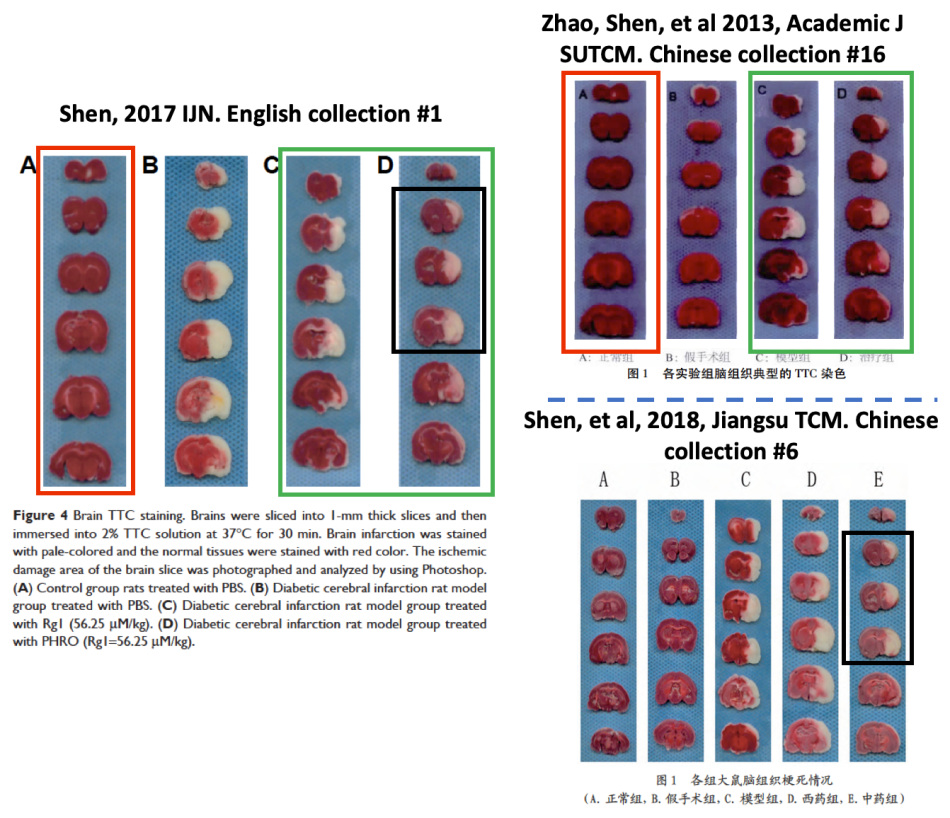
Also in that 2017 paper with Nanjing colleagues (Shen, et al IJN 2017, English Collection #1), the endothelial cells of Shen’s diabetic stroke rats that were treated with tail vein injection of ginseng nanoparticles had identical matrigel tube formation patterns in vitro as the cells from rats treated with oral gavage feeding of TCM herbal soup in his 2018 and 2019 Chinese papers (Shen et al Tianjin TCM 2019 and Shen et al Jiangsu TCM 2018, Chinese Collection #2 and #3). In these two Chinese papers, the treatment group of Shen’s rats was gavage fed with a TCM herb soup “Fuyuan Xingnao Decoction” and the effect of this soup was assessed for two different pathways of miRNA-503 and miRNA-320. Again, miraculously, the endothelial cells of those rats demonstrated identical tube formation results in both pathways, all because of the special TCM herb soup!
Maybe now is a good time to mention the “herbal” soup contains dried leeches.

It was not only the gulping of herb & leech soup and the venous infusion of ginseng nanoparticles which showed identical treatment effect for induced stroke in Shen’s diabetic rats: also having a stroke or not was only one image manipulation away in-between. A diabetic rat on which no stroke was induced (Sham surgery group) in Shen’s 2018 Chinese Collection paper #6 used to exist before, as a stroke-induced diabetic rat in Shen’s English Collection paper #1 from 2017, with its cerebral cortex deformed with supposedly infarcted brain tissue. The infarctious deformation was caused by some Photoshop stretching.
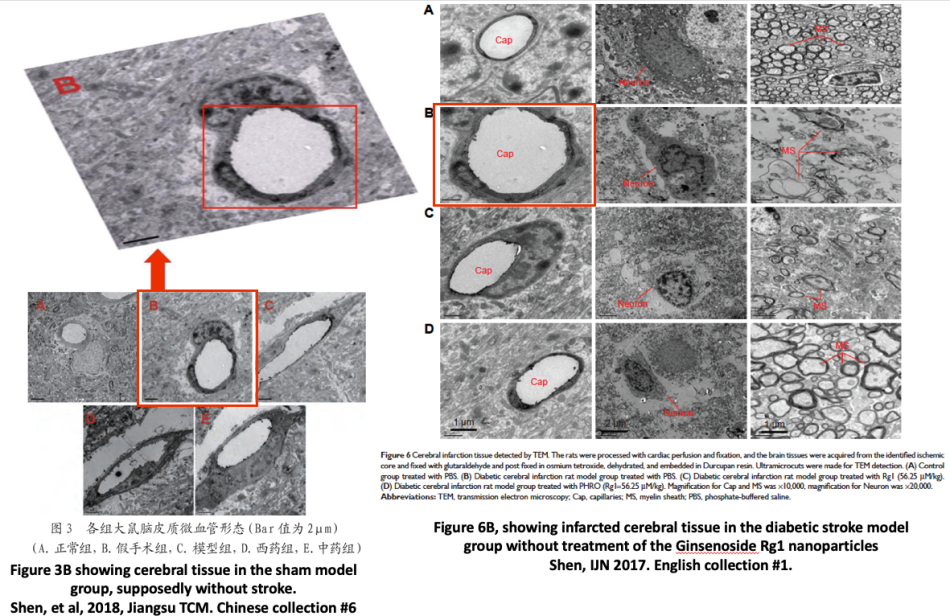
Of course, we should not forget that previously celebrated nanoparticle release curve, re-appearing once again in Shen’s latest publication, his January 2019 paper in Military Medical Journal of Southeast China

Acknowledgements got to a certain “Morty”, Elisabeth Bik, and friends in China for their help with compiling the Chinese Collection.
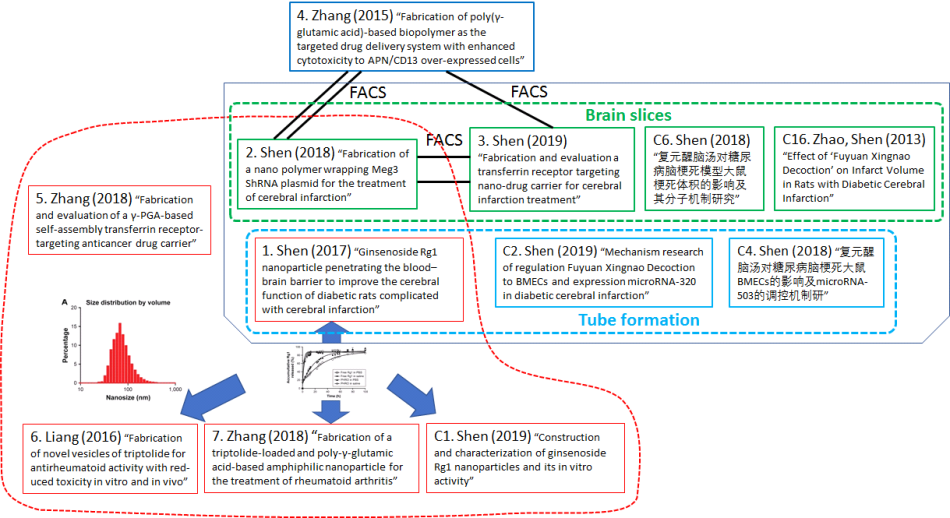
Now, if you are interested to try that all at home, here is the recipe for the miraculous Fuyuan Xingnao Decoction aka Awake Your Brain soup, concentration: 388g/L. Vegetarian & vegan warning: contains leeches!
| TCM name | English name | Weight (g) |
| 人参 | Ginseng | 10 |
| 三七 | Panax notoginseng | 10 |
| 石菖蒲 | Acorus gramineus | 12 |
| 水蛭 | Dried leeches | 10 |
| 益母草 | Leonurus japonicus | 30 |
| 生南星 | Arisaema heterophyllum Blume | 15 |
| 制大黄 | prepared rhubarb | 9 |

Donate!
If you are interested to support my work, you can leave here a small tip of $5. Or several of small tips, just increase the amount as you like (2x=€10; 5x=€25). Your generous patronage of my journalism will be most appreciated!
€5.00
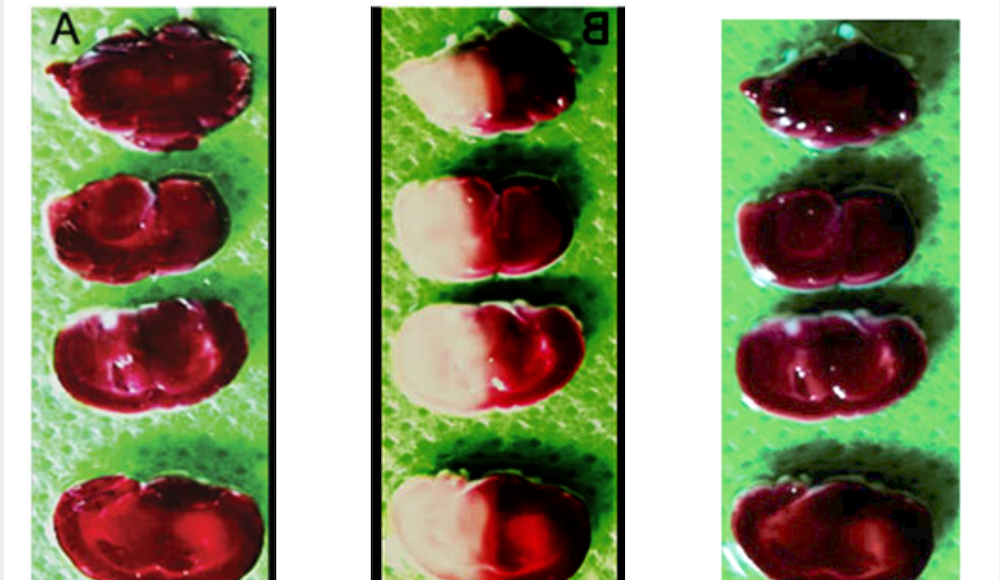

“Maybe now is a good time to mention the “herbal” soup contains dried leeches.”
That reminds me of
https://forbetterscience.com/2018/02/14/fried-divine-comedy-featuring-anti-cancer-cockroach-and-phallic-fungus/
“Jiang’s cancer-fighting magic ingredients are ginseng and other herbs, plus a cockroach”.
LikeLike
not only we have all sorts of preparation of animals in our herbal soup of TCM, our people are never shy when applying the taxonomy that human beings belong to animal kingdom. Looking into the classical works on TCM recipes documented in “Compendium of Materia Medica” (本草纲目), you’d find many human body parts or products (BTW this is a politically correct term for waste, etc) used in TCM treatment. It’ll blow your mind I promise.
LikeLike
“Yellow soup” comes to mind, as a cure for food poisoning (to induce vomiting).
https://www.ncbi.nlm.nih.gov/pubmed/26673501
Zhang et al (2012) were keen to establish it in the English-language literature as the true precedent for Fecal Microbiome Transplant therapy (other authors disagreed).
https://www.ncbi.nlm.nih.gov/pubmed/23160295
“For aesthetic considerations, the herb doctors did not label the fecal suspension by its original name, but called it yellow soup or used other exhilarating names.”
LikeLike
Damnit, I forgot to prepare the rhubarb, that’s why my Brain-Aware Soup didn’t work.
LikeLike
What initially appeared to be a smart plan by sharing images, but not publications, turned out not to be so after all.
The message is clear: there are no safe harbours for research fraudsters!
I am glad that our fight against systematic fraud in research shows the outside world how bad it has become, and
hope that these problems will be liftet to a political level.
We do need a paradigm shift in order to restore confidence in the scholarly literature!
LikeLike
Given how things are done in China, it seems worthwhile to propose that this nation is supporting a deliberate effort to break science. Perhaps it’s time to consider a quarantine along the lines of what they use to stop outside information from getting into China. I know I have become quite reluctant to cite, or even read, research coming from Chinese institutions. Once you set aside the fraud and outright garbage there’s not much left, so we could just leave them stewing away behind their own cyberwall with no loss. This does not of course apply to Chinese researchers in general, just to those operating in what is clearly a pointless swamp of fraud, incompetence, fake reagents and blatant patent infringement. We could widen the net to include a few other countries as well. There are not enough dedicated sleuths like SC to root this garbage out after the fact, so let’s just toss it all.
LikeLike
As sad as it is the reality, I personally avoid citing papers from China to a large degree. In most cases, I deny the review request for manuscripts submitted by Chinese authors. I know it sounds like discrimination, but I can’t afford wasting my time on fraudulent data and claims.
LikeLike
I can see why the Chinese science establishment came out in support of Plan S (though without officially adopting it). The internal research industry within China is essentially Plan S already – funders and publishers sharing out the money while scientists use whatever is left to fake results. It makes perfect sense to extend that model to the rest of the world.
LikeLike
It seems to be a really mess, involving a large number of researchers who simply do not care, strong hierarchy, lack of democracy and a free press (which is essential to highlight problems) and a high corruption level (you cannot trust essential products used in the lab, e.g. media, FCS, kits etc, due to high risk that their are counterfeit products).
China has a huge problem here, and I am afraid of the consequences for clinical trials and patient safety and for political decision-making.
I heard that a death penalty has been introduced for research fraud in China if there are consequences for patients, and also imprisonment for research fraud in general, but it doesn’t seem to help.
LikeLike
“I heard that a death penalty has been introduced for research fraud in China if there are consequences for patients, and also imprisonment for research fraud in general, but it doesn’t seem to help.”
“lack of democracy and free press”
Who gets to decide what is research fraud, or anything of importance, in China apart from the State? Are anti-corruption/anti-fraud drives to be taken at face value, or are they methods of the State removing people it does not like?
Is this post and and earlier post
https://forbetterscience.com/2018/02/14/fried-divine-comedy-featuring-anti-cancer-cockroach-and-phallic-fungus/
examples of State-sponsored scientific fraud?
LikeLike
https://www.mirror.co.uk/news/world-news/thirteen-chinese-drug-dealers-sentenced-10705921
https://www.theguardian.com/world/2017/dec/18/thousands-china-watch-executed-sport-stadium
https://www.independent.co.uk/news/world/china-executions-capital-punishment-death-penalty-state-killing-amnesty-international-a8300726.html
It’s not cuddly.
LikeLike
imprisonment for research fraud in general, but it doesn’t seem to help.
I was looking at some of the journals Tiger found in the search for Shen’s domestic production. “Jiangsu Journal of Traditional Chinese Medicine”. “Journal of Shanghai University of Traditional Chinese Medicine”. TCM officially works, according to Presidential decree. That means that biomed researchers are obliged to commit fraud if they want to stay employed… a bit like biologists and geneticists in Russia during the Lysenko period.
When research fraud is universal, actual prosecutions will be discretionary, arbitrary and whimsical.
LikeLike
after read this investigation I shared, my friends in China said the same thing. They are saying if you assume all publications with positive treatment effect of TCM are faked, you wouldn’t be anywhere far from the truth.
LikeLike
Everything in China is state sponsored. Unauthorized activities are stamped out, and those involved lose their lives and internal organs. If the Chinese army is publishing crap science, there must be a tactical purpose, just like the Russians don’t hack randomly. International science is an honor system, and the Chinese state is not honoring the spirit or the rules of that system. Nor are the Iranians, many Europeans and most Indians by the look of things. It would be crass to cut all of them out, but we need a “verified tier” of research outlets where crap detection and rejection is an integral aspect of the publishing process. Serious scientists do not have the time to check every little detail in submitted or published papers, and I for one have gotten fed up with pointing out to editors the woeful deficiencies in many papers they uncritically send out for review. Needless to say, nobody from Nature should be involved in establishing the “honest core.”
LikeLike
I understand your reference to Nature; however, Nature did act fairly quickly in retracting the Egyptian/Baylor paper on therapeutic T cells in brain cancer …… Texas Photoshop Massacre.
LikeLike
I hope that indicates they started to take research fraud more seriously. Hope for the best.
LikeLike
But what do we make the Brain Soup (trademark?) in? Is it 1L of beer or 200ml PBS? My leeches are almost dry so I need to know.
(Seriously though, excellent investigative work!)
LikeLike
388 g of the herbs and dried leeches in 1L of vodka
LikeLike
… I just don’t know. Most of those journals have sufficiently lowbrow reputation (e.g. generaly anything from Taylor-Francis is not mind blowing research, at least in my field). Why not measure the not-so-great data and then make the less-then-stellar articles out of it? You know, instead of making some shit up? I am sure they would be able to publish it in the same (or similarly impactful) outlets… Or do these people just get some kick out of doing fraud?
LikeLike
They get money for every paper in China. Higher impact factor – more money. More papers-more money. Low impact factor and many easy papers is one of strategies.
LikeLike
Remember, the researchers have already made shit up (for the papers published within the domestic market, reporting great results for TCM potions). Why not rearrange those faked or cherry-picked images into a new order, relabel them as coming from ginsenoside or something else more plausible than “dried leech soup”, and send them to a Taylor-Francis spigot?
LikeLike
The article titles fairly stat that those reports are about “fabrication”. So where is the problem? (sarcasm) But, being more serious, it is a pity that nanoparticle/nanomaterial science is like this.
LikeLike
Owlbert: “we need a “verified tier” of research outlets where crap detection and rejection is an integral aspect of the publishing process.”
The US National Library of Medicine should stop indexing the many journals publishing garbage. By implementing some quality control, thousands of low quality journals could have been left out in the dark, for the best of science, patients and society.
How did it happen that the scholary literature is now infiltrated by non-scientific bullshit journals from Dove Press, Taylor & Francis, American Scientific Publishers or Elsevier (to mention some of them).
LikeLike
I think its a win-win situation. They publish in Journals nobody reads anyway, the the lives of many animals are saved
LikeLike
It is somehow comforting to think that many innocent mice were saved from being sacrificed for pointless experiments. Even if these studies had been actually done they would have been pointless. A stark contrast to those 6,000 dead Spanish mice.
LikeLike
Pingback: Yubing Sun: contaminated science, Synchrotron fraud and citation scam – For Better Science
Pingback: Deliferate misteaks by Tradional Chinese Medicine – For Better Science
Pingback: The full-service paper mill and its Chinese customers – For Better Science